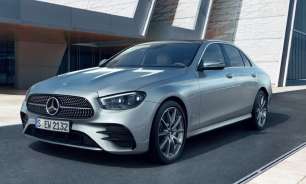Measuring 4650mm long (with a 2829mm wheelbase), 1845mm wide and 1660mm tall, the GLB35 is more like the GLC43 in size than the GLA35, making it a mid-size SUV despite its small underpinnings. And that is good news for practicality.
Cargo capacity with the 50/50 split-fold third row stowed is more than solid, at 565 litres (VDA), but it can be increased to a cavernous 1800L with the 40/20/40 split-fold middle bench also not in use. If six or seven passengers are onboard, though, there’s very little room to move.
Nonetheless, the boot is still well packaged, featuring a huge aperture, no load lip, and a flat floor, which make loading and unloading bulkier items a hell of a lot easier. And even the load cover can be stored underfloor when out of action. How good.
There are also four tie-down points, two bag hooks, a side storage net and a 12V power outlet on hand to make matters even easier, while the rear seats can be stowed from the boot.
While we’re on the topic, Mercedes-Benz says the third row can accommodate passengers up to 168cm tall, with the middle bench able to slide fore and aft by up to 140mm.
Yes, I'm too tall, at 184cm, but I can still sit in the very back, although not in total comfort. All in all, about a centimetre of legroom and negligible headroom and toe-room are on offer there for me.
That said, getting in and out in the first place is the real challenge here, with the middle bench unable to tumble forward for easy ingress and egress. Yep, you’re not going to look smooth either way. Children can deal with it, but adults won’t be thrilled.
Therefore, the middle bench is the place to be, even when it’s slid all the way forward. Behind my driving position, it offers about a centimetre of legroom, but this can be increased to several inches by sliding it all the way back.
Either way, plenty of toe-room is available alongside more than an inch of headroom. The latter is more impressive when you consider that’s what you get with the standard dual-pane panoramic sunroof fitted.
Even better, the second row can seat three adults at a pinch, partly thanks to the low transmission tunnel, which means there’s the right amount of space for six fully grown feet across the two footwells. It goes without saying children will again be fine.
Speaking of which, four ISOFIX and five top-tether anchorage points are on hand for fitting up to four child seats across the second and third rows, which makes the GLB35 a serious option for families that like to be sporty.
There are plenty of in-cabin storage options, with the large central storage bin featuring a pair of USB-C ports, while the glovebox is also quite useful, even if it is oddly shaped. And there’s also a sunglasses holder in front of the rearview mirror.
The centre console’s cubby isn’t really designed for storage, with it basically taken up by two cupholders, another USB-C port and a wireless smartphone charger.
The front door bins can accommodate one small and two regular bottles each, which is great, while their rear counterparts can take one small and one regular apiece.
Second-row occupants also have access to a fold-down armrest with another pair of cupholders, but being of the retractable variety, they’re flimsy.
These passengers also have two USB-C ports, with the pair folding out below a small cubby and air vents, which are found at the back of the centre console. Storage nets are also fitted on the front seat backrests.
And don’t worry; the third row gets in on the action, with two cupholders (one regular, the other small) splitting the seats, which have individual USB-C ports and device straps to the sides.






